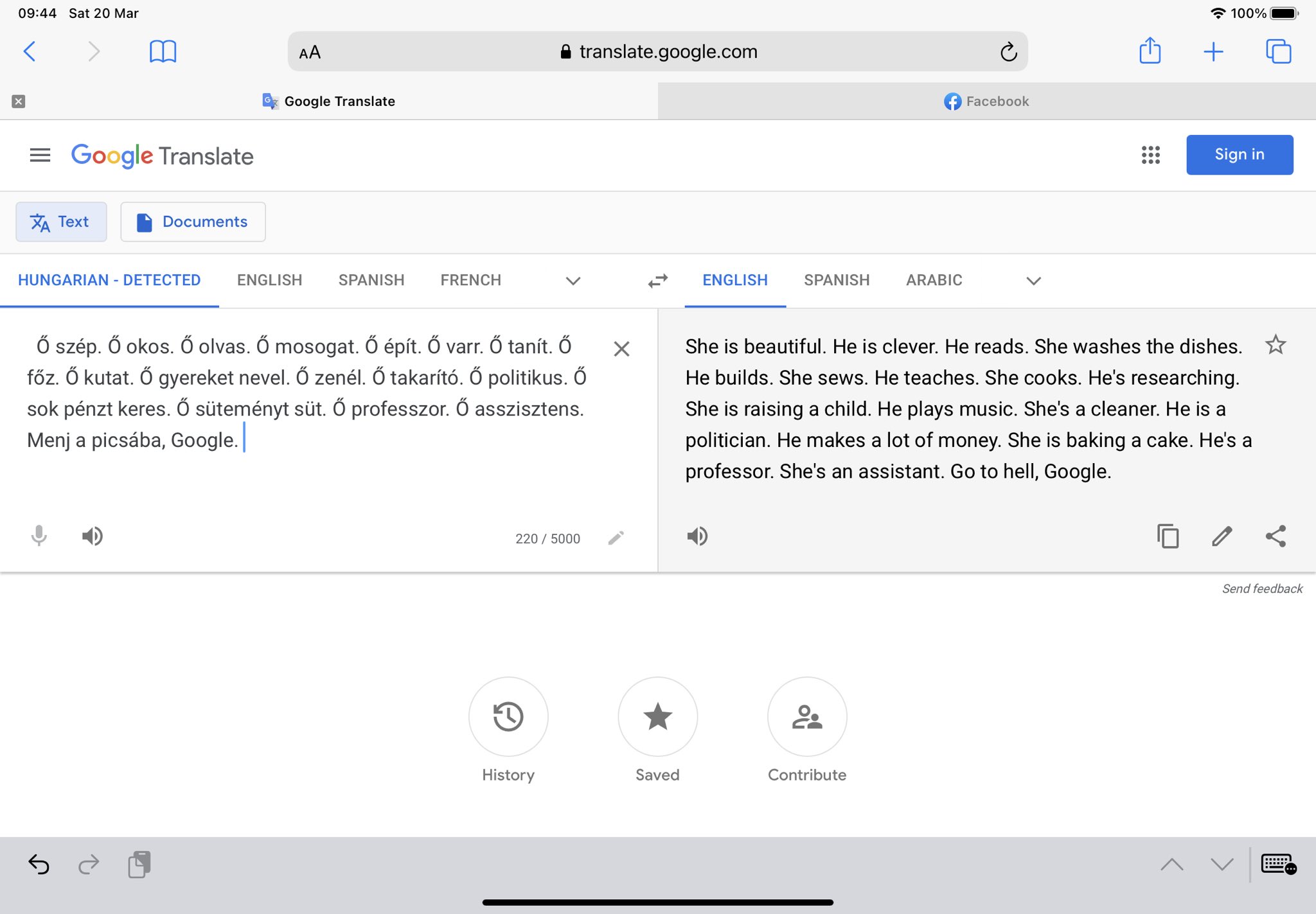In March 2021, a certain corner of the internet was shocked by a tweet which purports to highlight rampant sex-based bias in Google Translate. The tweet shows a translation from Hungarian, which has no separate pronouns for male and females, into English. The text contains several sentences of “he/she is X”. The English translation is not consistent with the gendered pronouns it assigns to the sentences. Some of the sentences assigned the male pronoun in English are “he is a politician”, “he is clever”, “he’s a professor”. The sentences assigned the female pronoun include “she is beautiful”, “she washes the dishes”, “she is raising a child”.

You would be forgiven for thinking that I got the date wrong. 2021, really? Haven’t we been through all of this before? I was questioning my own sanity when I saw this tweet. Google Translate’s sexist bias has been known for years, but what’s crazier is that Google is aware of the problem. They published a blog explaining the issue and the steps they have taken to avoid bias. The solution was, I thought, a perfect one; rather than assume gender when translating from a genderless language, they offer both male and female translations. Apparently, sometime since that blog Google have decided that that was the wrong solution and have reverted to assuming gender. Given their recent issues with AI ethics, this isn’t much of a surprise.
While the replies to the revalatory tweet were mostly ones of disgust, there were some well-liked and retweeted replies which blithely dismiss this as a non-issue. “Algorithms can’t be biased” is a oft-used retort to claims of unfairness borne from AI. Of course they can’t, but humans can, and algorithms are, for now at least, a product of fully human origin. “To be fair, it’s not Google’s fault”, begins one reply. “It’s using a statistical language model build [sic] from data scrapped [sic] from the web.” The second half of that statement is a matter of fact, but there is some logic missing which has caused the author to allow Google to abrogate responsibility. Google Translate is, after all, a Google product. Google engineers built it, Google product managers signed off on its release to the world, Google profit from it.
Deferring to “that’s just what the data looks like” is a neat way to avoid responsibility. Yes, it could well be true that “he is clever” occurs more times in the training data than “she is clever”. And yes, a model trained on that data would, without concerted interference, be more likely to output the male version of the sentence. If this data imbalance does exist, it could be down to several causes, some more benign than others. But Translate is not being trained on all text data in the world, merely a subset of it. Language datasets are often scraped from websites like Wikipedia and Reddit. Both of those sites have a male-leaning bias in contributor demographics, so it would not be surprising to find imbalances in gendered statements. Here we arrive at the first issue with the “it’s just reflecting the world” argument. The choice of dataset is an active choice by Google. If there is a bias, it’s not “just the way the data is”, it’s the way Google’s data is.
But arguing about whether the data’s bias is malicious or benign obscures a far more pertinent point. Google Translate, as demonstrated in that tweet, is a broken product. When we ask for a translation, we don’t care whether most doctors in the world are men. We don’t care whether women are more often referred to as beautiful than clever. We care about what the author of the sentence in question meant. We care about whether the individual in that text is a man or a woman. Translate has imported biases from elsewhere in the world into its translations, rather than looking in the text for the truth of whether the individual should be he, she, or they. You might rightly point out that there is no useful context in the translated paragraph which would allow Translate to do this. Yes, but a context does exist somewhere. Why should Google decide what this should be? When people use Translate, they don’t typically paste a whole text, rather the odd sentence or two, so translations are bound to be ambiguous. Choosing to import bias from the training data will produce incorrect translations and may confuse the user. The correct solution for when context cannot be decided is, as Google previously stumbled upon, to offer both male and female translations.
But as it turns out, Translate is bad at context. Beginning the paragaph with “David is a good man” will inform any human that all subsequent sentences would be referring to David, and consequently should be “he is” rather than “she is”. But the translation from Hungarian to English still makes the same sexist mistakes. Given that Translate can’t work out context very well, multi-gendered output should be the default.

The damning conclusion from this is not that bias in Translate exists, it is that it will continue to exist for a long time. Every machine learning engineer should by now be aware of fairness issues; top conferences have made concerted effort in recent years to promote research in fair ML. What’s more, we know that Google is aware of this issue, because they wrote about it three years ago. The fact that it remains suggests that it is a conscious decision by Google management to not fix it. Why? I couldn’t begin to guess. Has this stance been taken in other Google products? Almost certainly. So if Google Translate being a bit sexist doesn’t concern you, at least try to remember this the first time you step in a Google self-driving car.